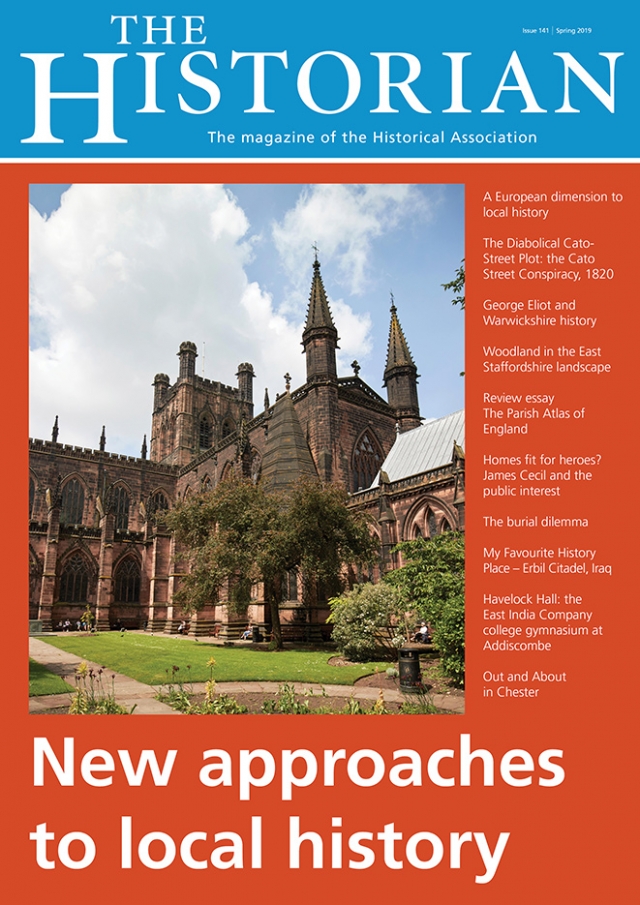Historian 141: Out now
Journal news

Editorial: New approaches to local history
The intention for this edition of The Historian was to raise the profile of local history by exploring some new approaches, or at least some new emphases. You will find that these include my attempt to expand from my original conditioning, as an ‘adherent’ of W.G Hoskins, to raise the prospect of Europe-wide comparisons; to using natural evidence; to consideration of studying places where specific events have taken place; to making parallels between past and present indicators of deprivation; and to using literature as a source for local historical exploration.
We practise our skills as historians in challenging times. ‘Austerity’ has meant that many services and facilities that we treasure have been under threat. A recent visit to Birmingham Museum and Art Gallery to see the exhibition of Leonard da Vinci’s drawings, from the Royal Collection, has reminded me of the fragile base on which we can still appreciate such delights. This free exhibition has been very popular and attracted large numbers of visitors. This cultural opportunity is taking place within a museum and art gallery which has now shifted from its direct relationship with Birmingham City Council into a charitable trust. This means that it has to generate its own income and so, when we go there, we always lunch in the splendid surroundings of the Victorian tea-rooms and then visit the shop in our own private attempt to help this great venture to succeed!
Another challenge to our role as historians, as I have mentioned previously, comes from over-excessive artistic licence being applied to television presentations of history. The late Chris Upton, a celebrated Birmingham historian, enjoyed his role as historical adviser to the production of Peaky Blinders, a drama with a strong West Midlands setting. He kept their output within the bounds of historical accuracy. What worries me about such contemporary dramas as the current series of Victoria is the use of generally correct historical information conveyed within inaccurate chronology. In the last episode while Prince Albert is seeking to become Chancellor of the University of Cambridge, which we know took place in 1847, at the same time Queen Victoria met Florence Nightingale at Middlesex Hospital. We know the latter did not begin her elementary training there until 1854. This may not seem that important but some of us have spent many years encouraging young people to have a sense of relative chronology, in other words seeking to understand events in the correct order and in relationship to each other.
This is not a self-serving attempt at job creation for myself but what Chris Upton offered to Peaky Blinders would be a good step forward for these various historical representations. It would also remove the distortions which misrepresent the role and nature of some major historical figures. In the present series of Victoria Sir Robert Peel has been forgotten, although he was directly involved in advising Prince Albert over the Cambridge chancellorship, and Lord Palmerston is represented as a rather flamboyant young man. At the time of the Great Chartist Petition of 1848, Palmerston was already 64 years of age. Obviously many of us will disagree about Palmerston’s foreign policy; my view is that, notwithstanding his ‘gunboat diplomacy’, his position as the successor of Robert Canning’s approach to overseas liberation movements is so important that depicting him just as someone who merely irritated the queen does him, and therefore us, an injustice.
As some readers of The Historian may have already calculated, this is the 50th edition since I became Editor in 2006. It continues to be a pleasure and a privilege to be so, especially as I only took over on what I believed was a ‘temporary basis’. You need to know that that the process depends very strongly on the professional design skills of Martin Hoare, to whom I am very grateful. We never know what may happen: a guest editor suddenly realises that the material planned is less extensive that had been anticipated or, on this occasion, one certainly promised item did not, in the event, materialise and the planned ‘favourite building’ had to be abandoned within the last week, due to very significant changes in circumstances at that particular location.
When The Historian was launched in 1983, it was intended to replace a General Series of Historical Association pamphlets which had been published over many years. As we approach our 150th edition, I believe that we have fully delivered on our promise to promote and encourage historical enquiry and to make it as accessible as possible. This is a publishing programme built entirely on voluntary effort, supported by Martin Hoare’s professional skills. Your ideas and contributions are always welcome.

